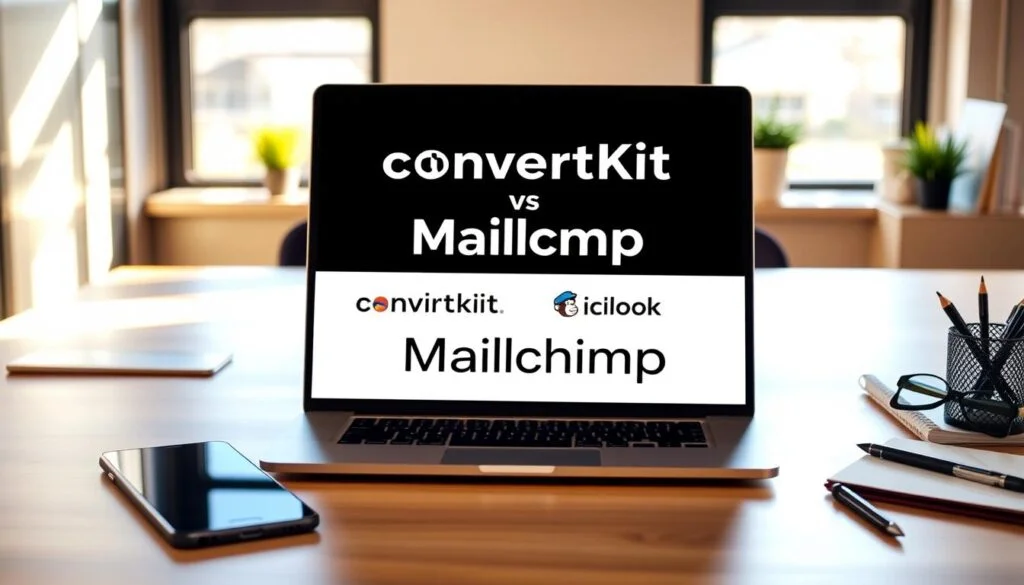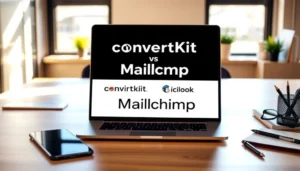ConvertKit vs Mailchimp Review
ConvertKit and Mailchimp are two of the most popular email marketing platforms among creators, both big and small. The site is always rated as the most easy to set up and use for automation – especially among bloggers, artists, and small business owners who want to grow their audience without any additional work. All you have to do is create email campaigns, segment your subscribers, and easily automate your messages from within ConvertKit – all from a single place. Their support staff is available 24/7 so you can always get help when you need it.
Table of Contents
ToggleTo the other hand, Mailchimp is one of the oldest and most advanced email marketing services out there. It has an amazing range of marketing tools such as advanced analytics, landing pages, and even e-commerce capabilities. Mailchimp also offers 24/7 customer support, which is key if you are going to scale and need more than just email marketing. Their platform is very flexible and you can keep on managing everything from newsletters to online stores.

ConvertKit vs Mailchimp
The Evolution of Email Marketing Tools
The wonderful progress in email marketing technology has been absolutely amazing and as a result technological advancements have played a major role in developing more sophisticated and user-friendly tools which have put a huge improvement on how businesses approach email marketing and enable them to create better targeting and effective campaigns.
Why Email Marketing Remains Essential
Digital marketing is still very much relying on email marketing as it is always directly linked with consumers. Email marketing helps nurture leads, increase brand awareness and make conversions seem much more likely. Below are several key statistics that show the importance of email marketing throughout the industry.
- Email marketing has an average ROI of $42 for every $1 spent.
- 72% of customers prefer email communication from brands.
- Email marketing is arguably 40 times more effective at attracting new clients / customers than Facebook or Twitter.
Key Factors in Choosing the Right Platform
When choosing an email marketing platform, numerous factors are crucial. These include ease of use, automation features, and customization options. A good platform offers robust analytics and integration. Consider these key points: ease of use, automation, customization, analytics, and integration.
- The platform’s user interface and learning curve.
- The availability of automation features and triggers.
- The level of customization allowed for email templates and content.
ConvertKit vs Mailchimp: A Comprehensive Comparison
To make it simple, ConvertKit and Mailchimp are two of the most well-known, popular and widely utilized email marketing platforms of today ‘s market. Both have a wide variety of features and functionalities which suit most of the possible email marketing requirements of people.
Company Backgrounds and Philosophies
ConvertKit is specifically optimized for professional producers like bloggers, authors, and online course creators. It was created primarily with the goal of providing a more efficient and automated email marketing experience for these users. Mailchimp, Mailchimp on the other hand targets a wider market of organizations and companies, and its philosophy is to provide a user-friendly platform that can work for whatever marketing the business may need, making sure their platform is flexible and easy to use for everyone.
Core Differences at a Glance
The major differences between ConvertKit and Mailchimp are the targets of each, and user platform strength. ConvertKit is meant for creators/bloggers/entrepreneurs who want to build and engage with their audience through email marketing. Mailchimp is built for the widest possible audience, small businesses/marketers and individuals who need an easy way to manage their email campaigns without learning a new platform.
Target Audience Focus
That’s why ConvertKit is for professional creators who need the best automation and segmentation tools to improve their work, whereas Mailchimp is a whole lot more versatile; it’s for all sizes and industries, no matter what kind of business you run.
Platform Strengths
The good points of ConvertKit are, as always, their visual automation builder and highly advanced segmentation capabilities. While Mailchimp is well known for its easy to use interface and its diverse library of templates.
| Platform | Strengths |
| ConvertKit | Visual automation builder, advanced segmentation |
| Mailchimp | User-friendly interface, diverse template options |
Pricing Structure and Value for Money
How much does it cost to use ConvertKit vs Mailchimp? Obviously, one of the most important decisions that business owners make is which email marketing tool to use. Both services have different pricing plans suited for different scenarios for different businesses.
. The important part here is knowing which of the two softwares provides the best value for your money.
ConvertKit’s Pricing Plans
ConvertKit offers a variety of pricing plans for businesses of all sizes and types. Our premium, medium and business pricing plans cater to the unique needs of each organization. Since our pricing plans cater to different organizations, they reflect the unique needs of each business in terms of their budget. Be it a small startup, medium company or large enterprise, ConvertKit has plans to fit your needs and budget.
Free Plan Limitations
The free version of ConvertKit allows creators to have up to 1000 subscribers, and includes basic features like forms, landing pages and email automation — all important for managing and engaging your audience.
Paid Tiers and Features
According to our research ConvertKit has paid plans that start from $9 / month (up to 1000 subscribers) and with more subscribers, you’ll pay more along with additional features like automations and priority support.
Mailchimp’s Pricing Model
Mailchimp provides various pricing plans. Their free plan is a great option for people and small businesses who are in the early stages of starting out or are willing to give it a try without making a commitment to a paid plan. The free plan is pretty basic and includes a few basic tools and features for use in small campaign/projects. This makes it easy for people to get an idea of what Mailchimp can do before making a decision to upgrade to a higher-end plan.
Free Plan Offerings
Mailchimp ‘s free plan can host up to 2, 000 subscribers and offers email templates, automation and basic reporting options to assist the user in starting mail marketing at no charge.
Premium Tiers Breakdown
Mailchimp ‘s paid plans start at $9. 99 you can have up to 500 subscribers, then the subscription cost is higher as your subscriber list grows with features like advanced segmentation, comparative reporting and even better support. I think the right way to know which platform is the better value for money is to conduct a granular comparison between their pricing structure and features side-by-side. This way we can actually take a closer look at all the things each platform offers and decide on the one we think is better.
| Features | ConvertKit | Mailchimp |
|---|---|---|
| Free Plan Subscribers Limit | 1,000 | 2,000 |
| Starting Price | $9/month | $9.99/month |
| Automation Features | Advanced automation | Basic automation in free plan |
User Interface and Learning Curve
In the world of email marketing user interfaces and the learning curve of a tool can make or break the overall user experience: good user interface design and nicely designed learning curves make everything much easier — great for productivity. And bad for efficiency.
ConvertKit’s Streamlined Interface
The great thing about ConvertKit is its simple interface. Every feature and function on the product was meticulously crafted to not overwhelm the user — even those who have never handled email marketing before. The dashboard on ConvertKit looks and feels organized and straightforward. It’s easy to find the functions and tools you need and don’t get overwhelmed by menus or interfaces.
Mailchimp’s User Experience
Also on the other hand, Mailchimp has a more complex and overall more user-friendly interface (although I can imagine it is a little more difficult for someone who’s first time using it to adjust). If you’re familiar with the platform and how it works, then you can start building your own email marketing strategy around all of the features and tweak it to your specific needs.

Onboarding Process Comparison
The onboarding process is also an area where both ConvertKit and Mailchimp differ dramatically. CreateKit offers a straightforward and easy onboarding process that includes comprehensive tutorials for new users to get started quickly and smoothly. Mailchimp offers tutorials and extensive guides as well, but the interface is more complicated and thus requires a larger amount of knowledge to learn which may make the onboarding process longer for new users.
Email Design and Template Options
Email design as well as the possibility for thousands of template options is one of the most important elements in creating a great email marketing campaign. A good email design can significantly increase the engagement and the conversion rate.
ConvertKit’s Minimalist Approach
The goal of ConvertKit is to offer email creators an easy to use email template platform that is minimalist in design approach. It provides simplicity in email creation which is advantageous for their business or use.
This style of email template allows you to send an appealing and visually easy email which was created with the intention that the user could easily use, find, respond to and act upon the messages thus you can focus more on content development and delivery without affecting the user experience in any manner.
Template Library and Customization
The templates available from ConvertKit are laid out to be both easy and effective – although it might not contain a wide variety of templates available, the ones in there are super customizable, so users can easily tailor their emails to the specific brand needs of their business.
Mailchimp’s Design Capabilities
Instead, Mailchimp is very well-known for its extensive design capabilities and its unmatched variety of templates. For the most part, users can access an unparalleled number of templates for every industry and every need. Whether a user needs templates for fashion, food or for any other industry, they’ll find them here. Each single one of these templates makes sure to cover all of an industry’s specific needs, whether it be newsletters, promotional emails or compelling marketing campaigns.
Template Variety and Editor Functionality
Mailchimp ‘s extensive collection of templates is one of its most powerful features, offering users an extremely diverse set of designs to choose from. There ‘s also an intuitive editor design to help make the process of customizing mailchimp to suit individual needs and wishes a breeze.
Mobile Responsiveness Comparison
Both ConvertKit and Mailchimp are well known for their responsive design, which allows emails to be viewed on any mobile device, from a phone or tablet up to a desktop computer. ConvertKit’s approach to design is much more minimalist which usually leads to faster load times, while Mailchimp has a pretty large number of templates that need to be optimized to be seen on multiple devices.
Key differences include:
- ConvertKit: : Simple, fast, and straightforward.
- Mailchimp: Feature-rich, varied, and highly customizable.
Automation and Workflow Capabilities
Automation and workflow capabilities are crucial for effective email marketing in any situation and ConvertKit and Mailchimp have very strong ones. When done properly automation helps automate the process, personalize the customer care and get better results.
ConvertKit’s Visual Automation Builder
Basically what convertkit has in terms of automations is only its visual automation builder which offers an intuitive user interface for creating highly automated customer journeys. This platform is most useful for artists or marketers who need to manage complex customer journeys without having to have any technical knowledge.
Sequence Creation and Management
With the help of ConvertKit, users can easily create and manage sequences. This allows them to create specific email series which are automatically run depending on the actions of their subscribers. This feature is especially useful for new subscribers or nurturing leads through a well-planned sales funnel.

Mailchimp’s Automation Tools
Mailchimp provides a massive arsenal of powerful automation tools, although its approach to automation differs from ConvertKit’s. Mailchimp’s strength lies in its extraordinary adaptability and the number and range of automation features available.
Customer Journey Builder
Mailchimp’s Customer Journey Builder tool allows users to create detailed and challenging customer journeys, all using a multitude of triggers and actions to enable very high personalization of the customer experience. This is particularly useful for e-commerce companies that want to automate marketing based on customer behavior.
Trigger-Based Actions and Rules
Both ConvertKit and Mailchimp have powerful support for trigger based actions and rules which allow you to automatically run your email marketing based upon certain triggers such as subscriber actions, or changes in subscriber data. There is basically the same difference between both the platforms in terms of how the triggers are implemented and how complex the rules can be created.
| Feature | ConvertKit | Mailchimp |
| Visual Automation Builder | Yes | No |
| Customer Journey Builder | No | Yes |
| Trigger-Based Automation | Yes | Yes |
In conclusion, both ConvertKit and Mailchimp offer robust automation and workflow capabilities, catering to different needs and preferences. ConvertKit’s visual automation builder is ideal for those who prefer a straightforward, code-free approach, while Mailchimp’s Customer Journey Builder offers versatility and complexity for advanced users.
List Management and Subscriber Organization
Find out how to best organize and manage your lists and subscribers in ConvertKit and Mailchimp. ConvertKit and Mailchimp are both popular with email marketers. Both have a lot of features and approaches to managing your lists and subscribers. They’re designed to make email marketing easier by making it easier to build, maintain, and engage your lists. So no matter how you want to segment your audience, develop campaigns that appeal to them, or manage your subscribers, they have a lot of tools for the job. .
A good list management strategy is essential in order to target the right audience and increase engagement. With ConvertKit’s advanced tag and segment system, you can categorize subscribers by behavior and preferences with a lot of accuracy. With this functionality, marketers can segment their audience to the very last detail by ensuring each group receives the content that fits their interests and behaviors best.
ConvertKit’s Tag and Segment System
With ConvertKit, you can create an infinite number of segments using the multiple criteria built into our platform to ensure your message makes it to the right people at the right time. As ConvertKit CEO Nathan Barry says – ‘segmentation is one of the main ways to make a good connection with the people who want to hear what you have to say. ’
“Segmentation is key to developing a meaningful relationship with your audience.”
Nathan Barry, CEO of ConvertKit
Mailchimp’s List Structure
Unlike ConvertKit Mailchimp uses an old school list structure where subscribers are divided into lists by some predefined criteria. This is quite easy to understand and it will probably not have the flexibility of using ConvertKit’s tagging system.
Contact Data Management Comparison
I think when it comes to looking at the capabilities of handling contact data, ConvertKit comes out ahead and looks way more granular with their pretty fancy subscriber management system. Mailchimp on the other hand seems to offer pretty good list management. But since they have more features than ConvertKit probably won’t appeal to too many users.
Finally, the decision between ConvertKit and Mailchimp for list management and subscriber organization comes down to the specific email marketer who wants the flexibility of more advanced segmentation and tagging and others who want to work with a simple, feature-rich list management tool: Mailchimp.
Integration Ecosystem
Email marketing success typically results from the integration of the platform that you choose with the tools and services already in use with your organization. An effective integration ecosystem will make an enormous difference in the function and success of your email marketing.
ConvertKit’s Native and Third-Party Integrations
ConvertKit offers native integrations with a number of common services, including the hugely popular WordPress blogging platform and educational service Teachable. It also supports third party integrations via services like Zapier, significantly increasing its compatibility with a vast array of other applications.
Mailchimp’s App Directory
Mailchimp is known for its extensive App Directory with integrations for over 300 applications, including popular services like Salesforce and Shopify Its broad directory makes it easy to link Mailchimp to a wide range of services, increasing its utility.
E-commerce Platform Compatibility
Both ConvertKit and Mailchimp offer e-commerce integration capabilities, to varying degrees: The table below describes the e-commerce integration capabilities of these two software tools:
| E-commerce Platform | ConvertKit | Mailchimp |
| Shopify | Yes | Yes |
| WooCommerce | Yes | Yes |
| BigCommerce | No | Yes |
In summary, both ConvertKit and Mailchimp have solid integration ecosystems that offer solutions for most needs and preferences. Constant integrations and support for Zapier – this is especially relevant for users who are looking for quick and easy integrations. Mailchimp’s App Directory offers a much wider range of direct integrations, providing a broader selection.
Analytics, Reporting, and Testing
If you’re trying to figure out how well your email marketing campaigns are doing, businesses will often turn to analytics and testing tools — ConvertKit and Mailchimp are the two best options at this point. They each offer a number of customizable features that will help you understand the success of your campaigns and make informed decisions from them.
ConvertKit’s Performance Metrics
ConvertKit offers a clean and user-friendly dashboard for analytics that focuses on campaign performance metrics (open rates, click-throughs, subscriber growth), so you can see how well your campaigns are performing without being overwhelmed by complicated metrics.
Mailchimp’s Analytics Dashboard
Mailchimp’s analytics dashboard is far, far more comprehensive, providing an incredible amount of fine-grained information about email performance metrics – opens, clicks, bounces and unsubscribes – as well as tracking for email client and device, so it offers a much more comprehensive and detailed picture of subscriber behavior.
A/B Testing Capabilities
Both ConvertKit and Mailchimp have great A/B testing features but they are radically different as to how they do it. ConvertKit is known for their very simple and intuitive A/B testing feature which is very user-friendly and really easy for users to implement. Mailchimp is much better suited for testing, it has a lot more features such as testing subject lines, email content, and even sending time.
Data Visualization and Insights
Effective data visualization is the key to gaining in-depth insight into complex analytics. Both ConvertKit and Mailchimp have data visualization tools, but Mailchimp visualizations are significantly more in-depth, ” a marketing expert said.The key to email marketing success is to get the right information from the right sources and use the data to gain valuable insights. By carefully analyzing and understanding your data to identify key trends, patterns, and customer behavior you can make the best business decisions, create content that people will care about, and increase conversion rates in your email campaigns.
“The key to successful email marketing lies not just in the data, but in the insights you derive from it.”
Both platforms are vital for users to obtain these valuable insights albeit in very different ways and methods. Both platforms offer in terms of extraction of such insights and provide various tools and features for users to explore and study the data ranging from advanced analytics, advanced algorithms, or user-friendly interfaces; All platforms have been designed with the user in mind when it comes to extracting meaningful insights.
Ideal Use Cases: Who Should Choose Which Platform
Because different authors and different businesses are different in terms of their needs & requirements, it is very important to decide which email marketing platform will best suit your needs. By knowing your specific needs, you can guarantee the platform will be the one that will deliver the most fit & functionality to your specific need. .
Best Scenarios for ConvertKit
ConvertKit is a great tool for creators who need more advanced automation and an easy to use product. It’s also perfect for bloggers, authors, and online courses creators who rely heavily on email marketing to engage their audience.
Creator Types and Business Models
Particularly suitable for professional bloggers who regularly post content regularly and want to automate their email sequences more efficiently – ConvertKit is among the top software for online instructors offering courses that wants to nurture leads via targeted email campaigns.
Best Scenarios for Mailchimp
In contrast with Mailchimp, which is so much more versatile in terms of its ability to take on a wide range of business scenarios (from smaller companies to larger ones) and provides more flexibility in terms of templates and interface design it’s perfect for business that prioritize visual branding.
Business Types and Marketing Needs
It ‘s especially designed for e-commerce companies that need to maintain a lot of product catalogs and send complicated promotions, as well as for small businesses that don ‘t need a whole lot of technical know-how when it comes to email marketing.
Conclusion: Making Your Final Decision
Selecting the right email marketing platform is vital, considering business needs, budget, and specific features needed. After comparing ConvertKit and Mailchimp, both have pros and cons. .
Selecting the right email marketing platform is vital, considering business needs, budget, and specific features needed. After comparing ConvertKit and Mailchimp, both have pros and cons. You can’t necessarily tell what each platform will do on the surface, but you should really think about your goals in terms of email marketing.
If you’re looking for a platform that serves up excellent automation features for professional email marketers, ConvertKit may be the way to go. If you want more of a flexible platform with more features and better integrations, then Mailchimp could be the right fit. Finally the decision between ConvertKit and Mailchimp comes down to your personal business needs and objectives.
By identifying your specific needs and researching and learning about all of the features offered by each platform you can make an informed decision which will help you succeed in your email marketing endeavours. The process in this regard is to identify your specific needs and research and learn about all of the features offered by each platform to ensure that you select the appropriate platform for your endeavors, which will ultimately help you succeed in your email marketing endeavours. .
FAQ:-
How do ConvertKit and Mailchimp handle automation?
ConvertKit is well known for it ‘s very advanced automation, which has a visual builder whereas Mailchimp has automation tools that are more traditional.
What are the pricing differences between ConvertKit and Mailchimp?
ConvertKit charges based on subscribers ( aimed at creators ), while Mailchimp charges on contacts ( and features ) and offers a free plan.
ConvertKit and Mailchimp integration with other tools / platforms?
Yes both sites allow integration with third party tools / platforms. Mailchimp however has a far wider app directory.
How do ConvertKit and Mailchimp manage lists and subscribers?
Since ConvertKit uses the tag and segment system vs Mailchimp uses a list structure. Both allow for many different ways to manage / organize subscribers.
What analytics and reporting do ConvertKit and Mailchimp provide?
Both platforms offer analytics and reporting tools like open rates, click-through rates and conversion tracking. ConvertKit does a much better job of providing performance metrics in details.
Can I use ConvertKit or Mailchimp for A/B testing?
Yes both platforms have A/B testing which allows you to test subject line, email content, and the best time to
ConvertKit vs Mailchimp

Discover the key differences between ConvertKit vs Mailchimp to choose the right email marketing platform for your needs.
Application Category: Review
4.49




